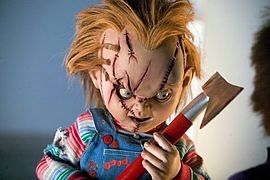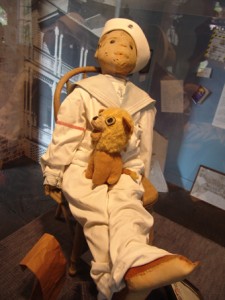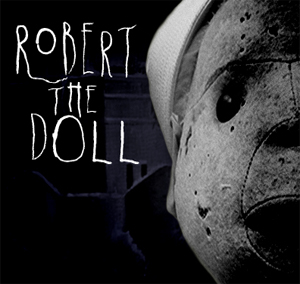Few folks know that Chucky had a real-life role model called Robert the Doll.

Chucky may be Robert the Doll’s descendant.
Chucky, of course, is the murdering Good Guy doll—possessed via voodoo by the spirit of serial killer Charles Lee Ray—who “stars” in the Child’s Play franchise, at last count six money-making movies. He probably never met his ancestor, but the DNA is undeniable.
The story of Robert the Doll begins in 1898 with the construction of a large, brooding house in Key West, Florida. Later known as the Artist House, the place was owned by Mr. & Mrs. Thomas Otto. Though well off, the Ottos treated their servants like crap. In 1906 one of those servants, a young Bahamian girl well versed in voodoo and the dark arts, had enough of the mistreatment and quit. But she presented the Ottos’ young son, Robert Eugene Otto, with a “gift”—a three-foot-tall straw doll in a sailor suit. The boy, called “Gene” by his parents, gave the doll his little-used first name, and throughout much of his childhood he seldom let Robert out of his sight.

Robert the Doll
From then on, misfortune seemed to haunt the Ottos. At the least, they would overhear long conversations between Gene and Robert, which they initially guessed was their son talking in two voices. Later on, they were convinced that the doll was actually talking, partly because they swore that on a number of occasions they witnessed Robert running from room to room or up and down stairs. They also heard Robert laughing, and moving about on the upper floor when everyone was downstairs. Neighbors swore they saw Robert darting from one window to another when the family was not at home.
This went on even after the Ottos put Robert in the attic. During the night they would hear young Gene screaming. Rushing into his room they would find furniture knocked over, the doll sitting at the foot of Gene’s bed, and the boy insisting that “Robert did it!” The Ottos lost many friends, all of whom were too frightened to enter their house, given the unsettling noises that emanated from upstairs.
Robert Eugene Otto, who as an adult would find some notoriety as an artist and writer, inherited the house after his parents died. Even then, the doll maintained a hold on  him. Now married, Gene rescued Robert from the attic, but the doll weirded out Anne, his wife, who swore she could see its facial expressions change. She wanted it back in the attic, but Gene insisted that Robert needed a room of his own, an upstairs turret-room.
him. Now married, Gene rescued Robert from the attic, but the doll weirded out Anne, his wife, who swore she could see its facial expressions change. She wanted it back in the attic, but Gene insisted that Robert needed a room of his own, an upstairs turret-room.
Gene finally returned the doll to the attic, but it continued to frighten people on the street, especially passing schoolchildren, from both the attic window—and the turret-room. Once, Gene found it sitting in a rocking chair looking out the turret-room window. He returned it to the attic, came downstairs—and found it back in the rocking chair. Anne would later sit in the turret-room to make sure the doll stayed put in the attic.
Gene Otto died in the early 1970s, and another family with a ten-year-old girl moved into the Artist House. At first delighted to discover a tattered straw doll in the attic, the girl soon discovered that she had entered a living hell. Robert moved around her room menacing her, sometimes attacking and even torturing her. Many a night she awakened her parents with her screams. Decades later she still maintains that everything she experienced was true, that the doll wanted to kill her.

The Artist House
These days you’ll find Robert the Doll residing at the Fort East Martello Museum in Key West, and he’s well guarded. Visitors can take his picture, but for some reason many cameras seem to malfunction when they try. Staffers and security guards report all manner of strange incidents in and around Robert’s display case.
The Artist House eventually became a bed and breakfast, as well as a historical site for those interested in hauntings. The turret-room and attic are both available for overnight visits, and many who stay there tell of footsteps, voices, and other weird things. Some believe that this is the spirit of Anne, watching over visitors and making sure that Robert doesn’t return.
Robert the Doll was no angel, but neither was he a monster like Chucky. Still, the greatest difference is that Chucky was a fictional character in a series of horror movies. Robert the Doll was—is—real.

While the Chucky movies were never my cup of tea, stories like this send deliciously creepy chills down my spine. Thanks for sharing another thought-provoking story that can’t help but make your readers wonder about the power of the dark side!
I just bought the six-movie set. What does that say about me? Some of them were deliberately funny, while the early ones–and, I think, the last one–were not meant to be funny but still had their moments. As ol’ Jack Burton says, “What the hell…” 🙂